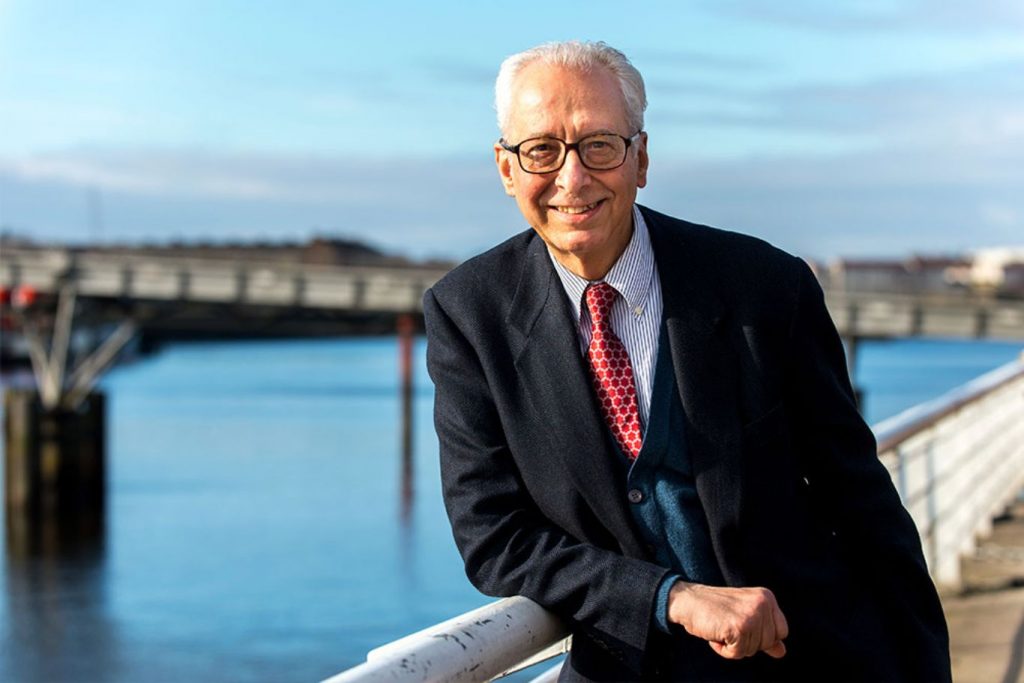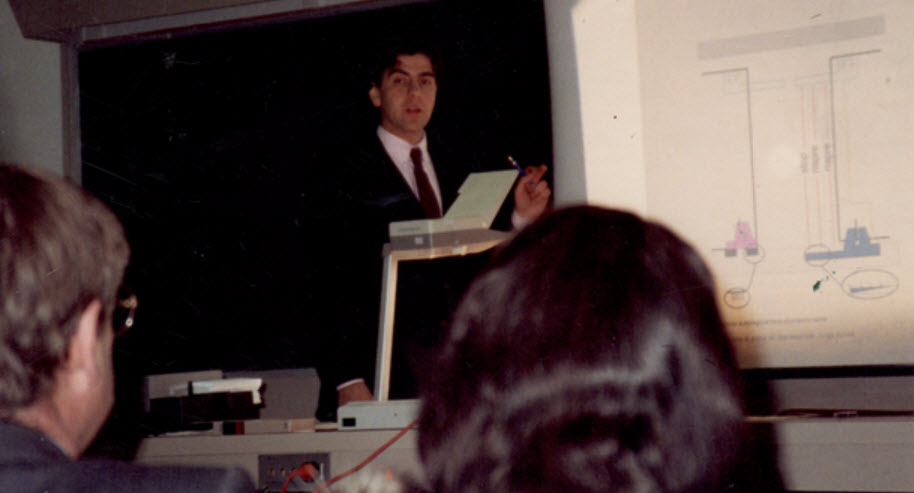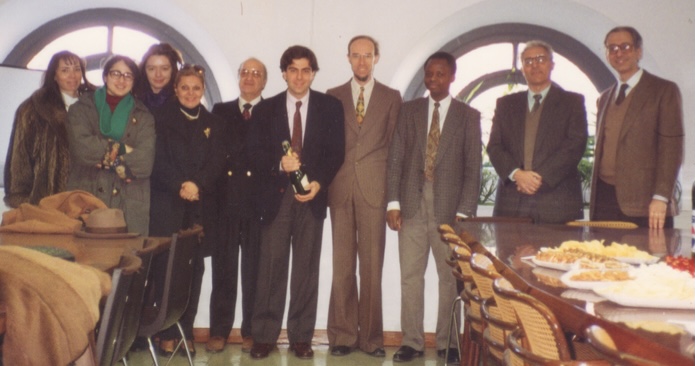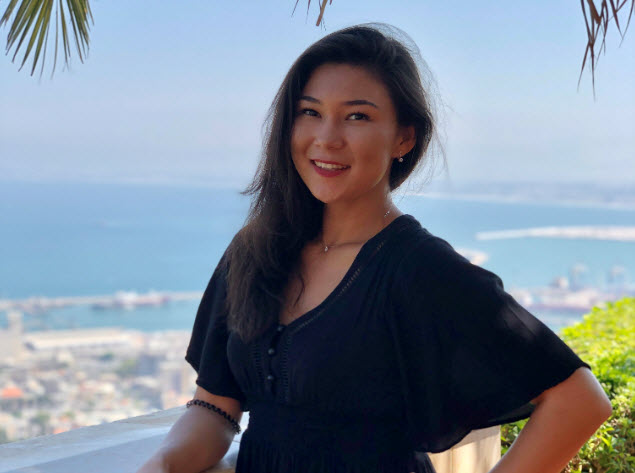Erasmus+ Origins: The Story of a Mythical Visionary and his “Lab Rat”
 Prof. Gilbert Daniel Nessim calls himself a “lab rat” for the Erasmus program. More specifically, Prof. Giancarlo Spinelli’s lab rat.
Prof. Gilbert Daniel Nessim calls himself a “lab rat” for the Erasmus program. More specifically, Prof. Giancarlo Spinelli’s lab rat.
Prof. Nessim is an Associate Professor in Bar-Ilan University’s Chemistry Department and the Bar-Ilan Institute of Nanotechnology and Advanced Materials (BINA).
“I’m Italian; I was born in Milan,” he says. “I started doing my MSc in Electrical Engineering at the Politecnico di Milano (Polytechnic University of Milan) and it was there that I met the late Giancarlo Spinelli. In the Erasmus world, he was a mythical person. He singlehandedly initiated a gazillion collaborations for Italy with many different universities across the world.
“In 1988, Prof. Spinelli wanted to start an Erasmus exchange program between the Politecnico di Milano, where he was Professor of Rational Mechanics in the Engineering department, and the École Centrale Paris, a prestigious French graduate engineering school, from which Gustave Eiffel was a famous alumnus,” says Prof. Nessim.
“Giancarlo was looking for volunteers, so I met with him and I was a fit, more than a fit. I was more advanced in my career than he wanted and older than the age group he wanted to send, but I had a super GPA and he worked it out. I went to be tested and ended up leaving Milan and going to Paris to the École Centrale for two years, leaving my Politecnico Engineering degree on hold.
“It was quite an adventure because it was not like it is today where you know exactly what you sign up for. At the time, we didn’t know which courses would be recognized, which would not, how much we’d have to do when we came back, how the grading would be affected, etc., etc. So, I went to France and I was, basically, a lab rat for the Erasmus program. I went there with three other guys; it went very nicely, and the rest is history,” he remembers.
The Legendary Prof. Giancarlo Spinelli
Fostering growth in the internationalization of higher education was always a priority for Prof. Giancarlo Spinelli. He was the Rector’s Delegate for International Networks and Professor of Rational Mechanics at the Politecnico di Milano, the highest-ranked Italian university in the world today, and he was responsible for the Erasmus program from the time it was founded in the late 80s.
 The program was not called Erasmus Plus in the beginning. It was known as Erasmus T.I.M.E. – ‘Top Industrial Managers for Europe’, later to become the independent ‘Top Industrial Managers for Engineers’.
The program was not called Erasmus Plus in the beginning. It was known as Erasmus T.I.M.E. – ‘Top Industrial Managers for Europe’, later to become the independent ‘Top Industrial Managers for Engineers’.
Erasmus+ is the EU’s program to support education, training, youth, and sport in Europe. Its billion-Euro budget provides opportunities for more than four million Europeans to study, train, and gain experience abroad, and vice versa.
“Giancarlo was liked very much; he was a very sweet person, a great professor, and very entrepreneurial,” says Prof. Nessim. “He saw this Erasmus program before anybody else. And he really put his soul into it. He could have done much more research, but he sacrificed his personal research to make this a success for others, for his beloved students. Through his efforts, the Politecnico was connected to a bunch of universities and countries, and today, students have so many opportunities to study in other countries and to grow.”
Prof. Spinelli was also a past President of the European Association for International Education (EAIE) and was active in the European Credit Transfer and Accumulation System (ECTS) from when it was a pilot project. The ECTS is designed to make it easier for students to move between countries and to have their academic qualifications and study periods abroad recognized. (Photo of Prof. Giancarlo Spinelli: Courtesy: EAIE)
Two Master’s Degrees
After two years, Prof. Nessim graduated from the École Centrale Paris and then started as a Research and Development (R&D) Engineer at Otis Elevators in France. A couple of years later, he decided to return to Italy to finish his Italian Master’s degree. He did this by presenting the invention he had developed at the R&D center (an infrared door detector). Ultimately, his credits from France were recognized, he graduated with his French degree with distinction, and his top Italian GPA was maintained.
“I only had to do my thesis presentation and I presented the invention I worked on for over two years. It went very well. I passed my thesis with the examiner, the late Prof. Brinis (who taught me Rational Mechanics). During the presentation, she asked, ‘How many distinctions can we give him?’ To the delight of my proud parents and of Giancarlo,” he says.

Prof. Nessim presenting his thesis at the Politecnico di Milano (1993)
“I think I can safely say that I was the first Erasmus T.I.M.E. student to graduate with the two degrees, one from the Politecnico in Milan and one from the École Centrale in Paris, and I may even be the first to have two overlapping degrees from Italy and France. This was my Erasmus experience – more than 30 years ago.
“After I presented and passed my thesis, I celebrated with my parents, mentors, and friends. Prof. Spinelli was there to celebrate with me. It was an amazing day for me. I still have the photo of the celebration taken after the presentation in the office of the then Dean of the Faculty of Engineering, the late Osvaldo De Donato. It brings back wonderful memories. I’m the one with the Champagne bottle,” says Prof. Nessim, smiling.

L-R: Dottoressa Asti (assisted Prof. Spinelli), Dr. Flavia Sparacino (came to ECP a year after, then went to MIT, and then started her own company),
Prof. Claudia Dallera (came a year after to ENSTA and is now Associate Professor in the Physics department at the Politecnico),
proud mother and father, Prof. Gilbert Daniel Nessim, Prof. Pierre Lecoy (Prof. Nessim’s mentor in the Electronics department at ECP),
Leandre Adifon (mentor from Otis Elevator, then became worldwide chief of R&D), Prof. Osvaldo De Donato, Prof. Giancarlo Spinelli.
Benefits of the Erasmus Program
“The Erasmus program changed my life completely. Today, I would’ve been doing who knows what? I’d probably be in Italy, not having traveled anywhere. I went on the exchange program and I ended up with two Master’s degrees from two countries with two languages, having expanded my mind tremendously compared to what it was before. It was a life-changing experience,” he says.
“At the time I did it, having two graduate degrees was very unusual. Today, there are so many more people with graduate and postgraduate degrees and it’s impressive, but not unusual. When I did it, it opened tremendous doors because it was, ‘Wow, this guy has two Master’s degrees, one from France, one from Italy, and both from top institutions in their respective countries’. It opened the door for me to do a prestigious MBA at INSEAD (France), which was extremely competitive.”
Prof. Nessim followed this with more than a decade in management consulting in hi-tech and then joined small companies in England and the US. He eventually decided to return to science and academia because “I felt like I was diluting myself in the business side”.
“I was missing science and technology and was fascinated by the emerging field of nanotechnology,” he says. “I presented some ideas about entering the field to my good friend Sammy Simnegar and he said, ‘Daniel, you should do a PhD at MIT’. So, in 2004, at the age of 37, I applied to my dream university, the Massachusetts Institute of Technology (MIT). I was not a typical PhD candidate, coming with an MBA and a decade in industry. However, I had two prestigious Engineering degrees and a sky-high GPA from the Politecnico, which, I believe, were what convinced the MIT committee to allow me into the Materials Science and Engineering program.
“Thanks to Erasmus and what happened as a result of the program, I have lived in Italy, France, US, England, and Israel; I’m trilingual – Italian, French, and English – and somehow manage with Hebrew. My life would never have turned out like this without the Erasmus experience,” says Prof. Nessim.
The Journey to Bar-Ilan University (BIU)
Prof. Nessim researched the synthesis of carbon nanotubes in Prof. Carl V. Thompson’s group at MIT and successfully presented his PhD thesis in 2009. He then spent an interim year as a postdoc in a collaborative project between Prof. Thompson (MIT) and Prof. Doron Aurbach (BIU).
“After my postgraduate studies, I wanted to find a faculty position in the States,” he says. “It was 2009, when Bernie Madoff made his horrible mess, brought the financial mood down, and faculty positions became rare. It really was a disaster.
“But I was fortunate to meet Prof. Aurbach and, after my postdoc, Bar-Ilan University offered me a position. In 2010, I joined the Chemistry Department and the Bar-Ilan Institute of Nanotechnology and Advanced Materials (BINA) as Lecturer, was promoted to Senior Lecturer with tenure in 2014, and Associate Professor in 2018. I lead the laboratory for the synthesis of nanomaterials. In 2020, I was appointed President of the Israel Vacuum Society (IVS), just when the Chinese virus kicked in, so all our conferences have been done via Zoom since then,” says Prof. Nessim.
Full Circle
Prof. Nessim is paying his life-changing opportunity forward. Over the past six or seven years, he has been very involved with the Erasmus+ International Credit Mobility (ICM) (exchange) program. He has developed contacts between Bar-Ilan University and many Italian universities, including Bergamo, Ca’ Foscari, Brescia, and Politecnico di Milano, and has worked closely with Daniel Schuval, Director of Academic Partnerships and Projects and the Erasmus+ ICM Coordinator at BIU’s International School, to make the program a success.
“Being Italian, I somehow have an advantage, I think,” he says, laughing. “I’ve made a lot of contacts and, together with Daniel, we have arranged some exciting mobility programs. We were very successful in securing multiple grants. I personally went to teach a course on the kinetics of materials at the University of Bergamo twice. It was a fantastic experience – and I got to see my family in Milan, which was amazing.
“I was supposed to go and teach the same course at the Politecnico di Milano, which would’ve been the dream of my life, but then this evil virus came around. It has been very frustrating.”
On the student exchange side, it is a little more difficult. According to Prof. Nessim, the main problem with the exchanges is that students here in Israel are, fortunately or unfortunately, older and at a more advanced status in life than Europeans.
“They’re older because they’ve done military service and they’re usually married with children,” he says. “It’s much trickier to take students like this and persuade them to spend six months overseas than to take a 23-year-old Italian single person and say, “go and spend six months in Israel.” It’s not very symmetrical, but we still had some successful exchanges over the years.”
 One of the more recent fruitful student exchanges was Madina Telkhozhayeva, a doctoral student in Prof. Nessim’s lab, who went to Ca’ Foscari University in Venice for six months. Madina is different from the usual outgoing Israeli students. She is one of BIU’s international PhD students and comes from Almaty, Kazakhstan.
One of the more recent fruitful student exchanges was Madina Telkhozhayeva, a doctoral student in Prof. Nessim’s lab, who went to Ca’ Foscari University in Venice for six months. Madina is different from the usual outgoing Israeli students. She is one of BIU’s international PhD students and comes from Almaty, Kazakhstan.
“Madina is a fantastic student in my group,” says Prof. Nessim. “She’s not an Israeli, so she didn’t go through the army, and she’s young and single. We gave her the opportunity and she was ecstatic about spending time in Venice. During her program, she worked with many interesting people, some of whom I’d already started collaborating with before, and she had a blast. We published one joint paper from that experience and we are about to submit a new one.”
There is another dynamic that goes on, which Erasmus is probably aware of, and that’s the fact that professors do not want to let their top students out of their labs for six months. However, Prof. Nessim understood more than most the benefits of the experience and recommended Madina for the program.
“There’s no question that it’s a great experience, and even though I knew I would have to sacrifice having Madina in my lab for a while, I knew this would be a tremendous growth opportunity for her and possibly, would lead to a few papers from the collaboration, which was one pay-off. My goal is to make sure my students succeed; for Madina’s career, this was the best thing that could’ve happened to her,” he says.
Madina cannot speak highly enough of her time at Ca’ Foscari and in Venice. You can read her story here.
When it comes to advising his students, Prof. Nessim says, “Do it! Absolutely, do it! Don’t stay insular. Obviously, I’m talking about normal times, not the crazy times we are in today. In normal times, I would say absolutely. Take six months. Take a year. Take two years. I went for two years and my path was completely changed. It’s a very enriching experience to be in a different culture with a different language and different ways of doing things, and it really opens your mind in an amazing way. It’s a unique opportunity that no one should pass up.”

Before Purim in 2020, Prof. Nessim sent his lab students a fun, edited photo of all of them to celebrate the holiday. L-R: Bibhudatta Malik (PhD candidate), Dr. Sumit Majumder (postdoc), Baruch Hirsch (PhD candidate), Dr. Pola Schriber (completed her PhD in December 2019), Rajashree Konar (PhD candidate), Dr. Efrat Shawat Avraham (postdoc), Madina Telkhozhayeva (PhD candidate), Jonathan Richter (Master’s candidate), Alina Yarmolenko (Master’s candidate), Dr. Arka Saha (joint postdoc with Prof. Malachi Noked), Dr. Tarik Aziz (completed his PhD in January 2021), Prof. Gilbert Daniel Nessim (as Superman), and Dr. Eti Teblum (lab manager, as Batwoman).
Contact Us for More Info
Leave your details and we’ll get back to you soon

